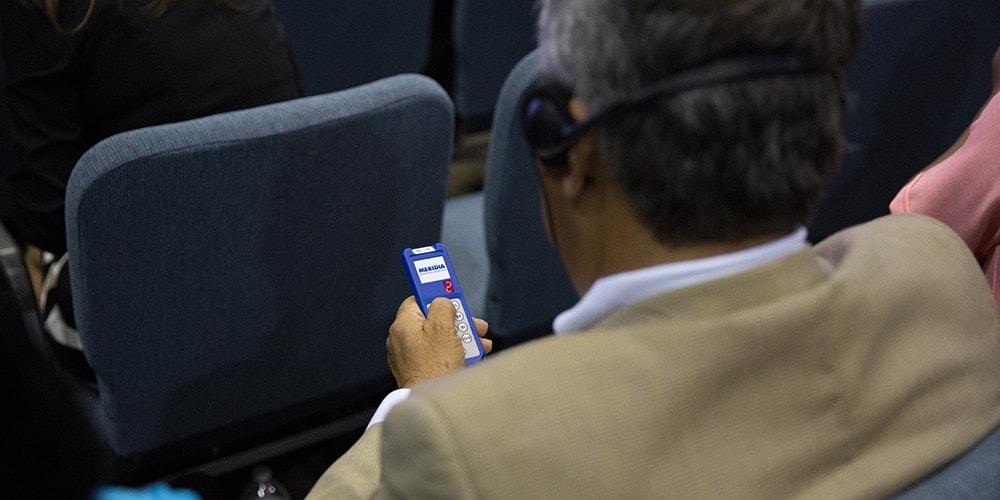
The electronic voting system—a first use for a General Conference (GC) session, replacing the handheld voting cards—didn’t quite go as planned during the initial Thursday morning business meeting.
When the system registered only a few hundred of the 1,800 delegates’ votes over three attempts to respond to a practice question, platform chair Lowell Cooper finally told delegates that “for the balance of our business this morning, we will use the voting cards.”
The high-powered Alamodome Wi-Fi system apparently was the culprit. Delegates pressing wrong buttons and some registering too late while waiting for translation also were factors, church leaders said.
The issue still wasn’t resolved during a second attempt at noon. A third try late in the afternoon appeared successful, but another test of the voting system on Friday did not produce the desired results. Delegates will continue to vote with voting cards until further tests confirm the reliability of the electronic system.
“As we move forward with technology, we are confident that we will have a reliable electronic system for this GC session,” said Nancy Lamoreaux, chief information officer for the General Conference.
The electronic voting system was used effectively this past October at the world church’s Annual Council held in Silver Spring, Maryland. No problems were experienced during those meetings.
During registration each delegate was given a voting device, which looks similar to a TV remote, and instructed to take it to every business meeting.
“Wear it like a piece of clothing,” Cooper, a general vice president for the General Conference, told the delegates when explaining from the platform Thursday morning how the device worked. “Every delegate is to bring this device to every meeting.”
He then added that the delegates are “fully responsible for the security of this device. Do not loan it to someone else. . . . The GC will not accept responsibility for anyone claiming to be denied the right to vote because the voting device was left in a hotel room or lost.”
Buttons with numbers 1 through 9 are on the face of the device. To vote “yes,” delegates press number 1; to vote “no,” they press number 2. Delegates may also abstain from voting.
Two platform screens register not only the number of “yes” and “no” votes but also the percentages of both.
“Some votes require a two-thirds majority, and that will also be calculated by the system,” Cooper said.
When the chairperson of the business session repeats a motion and indicates that delegates should prepare to vote on an issue, a time counter appears on the bottom left of the platform screens. It counts down seconds from 45 to 0. During that time, the system registers the votes.
The device has an on/off switch and “is always ready to work,” Cooper said. “It uses long-term batteries that will remain active throughout the session.”
Meridia Audience Response, an outside company based in Pennsylvania, provided the electronic voting equipment and devices. Their technicians are on site managing the complete voting system during the session.
Karnik Doukmetzian, general counsel for the General Conference, told delegates that issues of security, accuracy, and confidentiality were behind the change.
“No one is able to tamper with the devices and your privacy, so no one else will know how you voted,” he said. “Security protocols for these machines are generated each and every day, and they are changed every day to ensure the security of our votes. Your vote is transmitted securely, accurately, and anonymously in an encrypted fashion so the vote cannot be tampered with. Once the voting is completed and tabulated [for each vote], the records will be deleted. Your voting is secret and anonymous.”
Doukmetzian also explained that votes are registered only when the delegates are on the delegate floor, but not when they are sitting in the stands.
Response to electronic voting was mixed. Trans-European Division delegate Keth Holm said she had been looking forward to using the new system.
“It will be more convenient, more anonymous, and it will be really nice to get the numbers accurately,” she said.
Jaime Rodriguez of the North American Division agreed, calling it a “great idea.”
“It keeps your vote confidential,” he said. “This is very smart. This is a divine thing. It’s from God.”
Yuriko Ishida, a first-time delegate from the Northern Asia-Pacific Division, however, wasn’t yet convinced that electronic voting is the way to go.
“I’m concerned [about whether] it is going to be safe, if it will actually be better than the voting card,” she said, adding: “But . . . it does speed things up.”
Although the electronic voting system experienced an underwhelming start at the session, the church’s technology team said indications are strong that incorporating this technology into the business meeting processes of the church will enhance the accuracy, speed, confidentiality, and security of the delegate voting system.
Sandra Blackmer and Kimberly Luste Maran are assistant editors of Adventist Review.